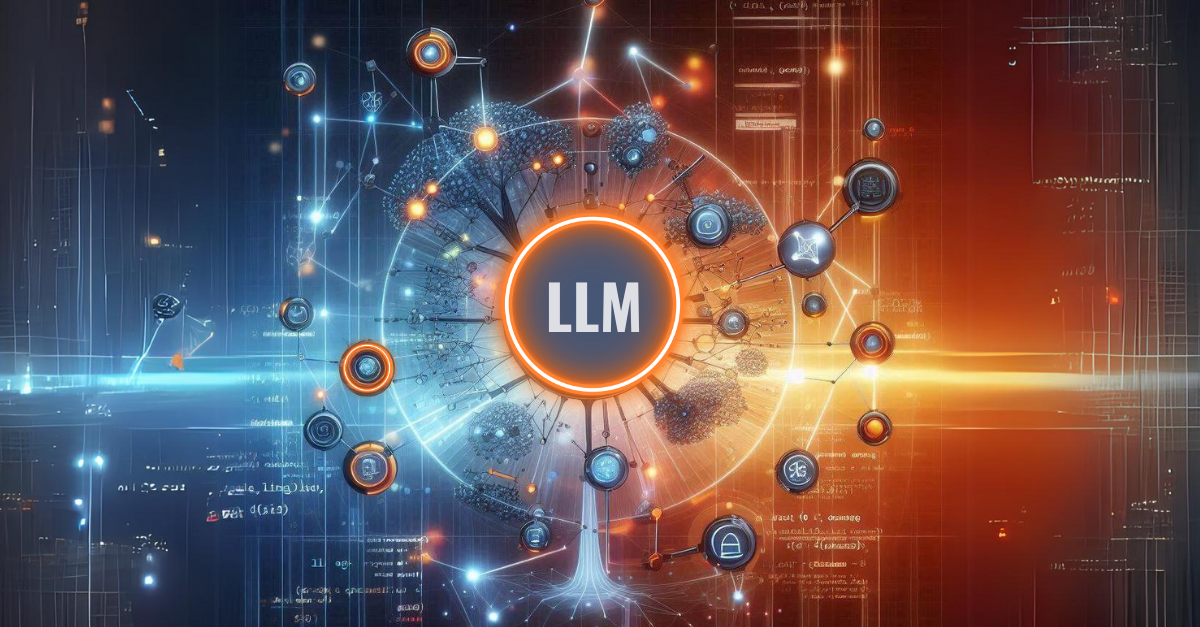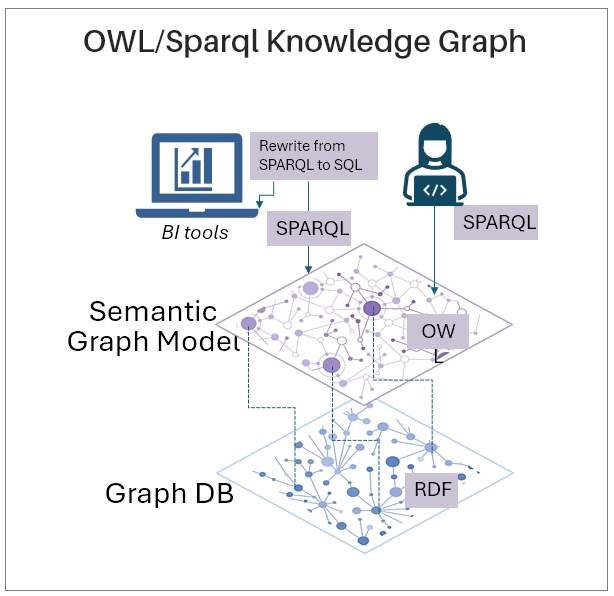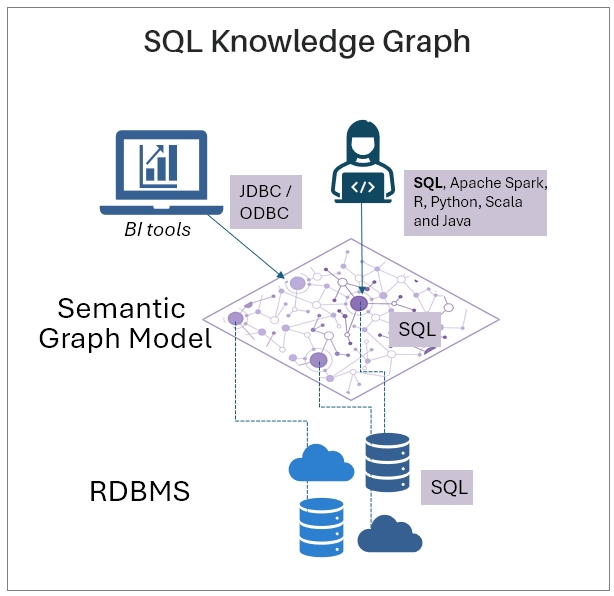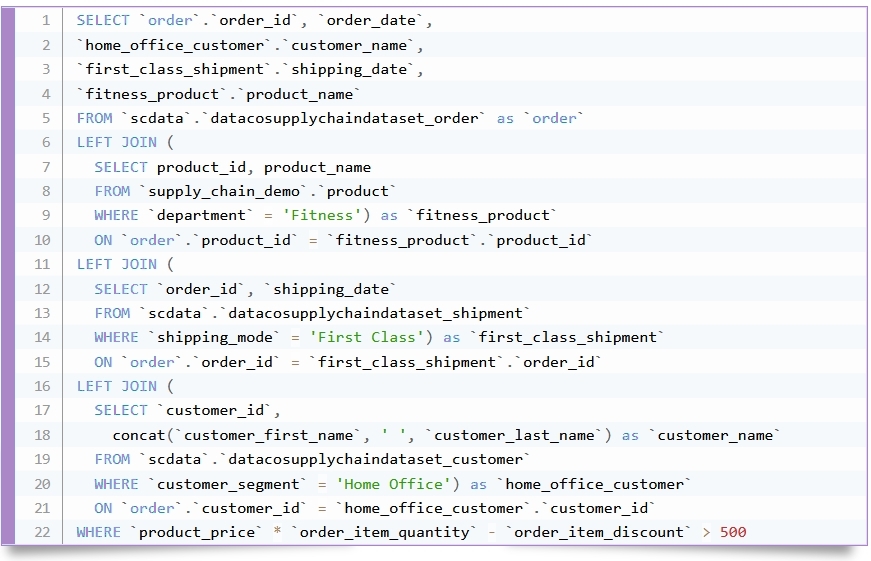
In a previous post, we discussed the need to include knowledge graphs as an integral part of an enterprise LLM strategy. This post discusses how knowledge graphs can be more confidently used to enrich LLM responses.
The ability to efficiently query and extract insights from complex databases is one of the main challenges of data practitioners. Large Language Models (LLMs) have shown remarkable potential in generating SQL queries from natural language inputs (i.e. Spider, Bird). However, when we introduce SQL knowledge graphs into the equation, we open up new possibilities for even more accurate and efficient query generation. This blog post explores why LLMs can generate more accurate SQL queries when addressed to a SQL knowledge graph instead of directly to a database, and examines the types of queries where this approach makes the most significant difference.
What are Knowledge Graphs?
Knowledge graphs are structured representations of information that capture entities, their attributes, and the relationships between them. They provide a powerful way to organize and query complex, interconnected data. Knowledge graphs have gained prominence in recent years due to their ability to represent and reason about information in a way that’s closer to human understanding.
Types of knowledge graphs:
1. OWL-SPARQL Knowledge Graphs: These are based on the Web Ontology Language (OWL) and use SPARQL (SPARQL Protocol and RDF Query Language) for querying and use a graph database for storing data. They excel in representing complex, hierarchical relationships and supporting logical inference. OWL-SPARQL graphs are widely used in semantic web applications and are particularly strong in domains requiring sophisticated reasoning capabilities
2. SQL Knowledge Graphs: These leverage familiar SQL (Structured Query Language) to represent and query graph-like data structures. SQL knowledge graphs map directly to any SQL fluent database, bridging the gap between traditional relational databases and graph-based data models. They are particularly suitable as smart semantic layers for business applications with existing SQL-queryable sources of data.
3. Hybrid (Virtual) Knowledge Graphs: The Hybrid knowledge graphs virtually map RDBMS to a graph model. Natural language queries are translated into SPARQL, and then the hybrid system translates these SPARQL queries into SQL for execution on the underlying relational databases. This method allows organizations to leverage the semantic richness of graph queries while still utilizing their existing relational database infrastructure.
Understanding SQL Knowledge Graphs
SQL knowledge graphs, create a virtual semantic layer on top of one or more databases. This layer defines entities, attributes, and relationships in a way that’s more intuitive and closer to how humans think about data. It allows users to query the data using simplified SQL statements that leverage these predefined relationships, without needing to understand the underlying database structure. This approach offers several key features:
- Virtual SQL Ontologies: Users can create ontologies that map to multiple databases, integrating data through the semantic layer.
- SQL-Based Querying: The knowledge graph is queried using standard SQL, making it accessible to those already familiar with SQL.
- Query Push-Down: When a user queries the ontology, Timbr translates and pushes down the query to the mapped databases.
- Simplified Querying: Complex JOIN operations are replaced with explicit relationships defined in the ontology, simplifying query construction.
- Semantic Richness: The graph structure allows for more intuitive representation of relationships between entities, closer to how humans conceptualize data.
By providing a semantic layer that sits atop existing databases, SQL knowledge graphs allow for more intuitive data modeling and querying. They enable users to ask complex questions of their data using simpler SQL queries, as the complexity of data relationships is encapsulated within the knowledge graph structure.
This approach not only simplifies query writing but also potentially improves query performance, as the knowledge graph can optimize queries based on its understanding of the underlying data relationships. Furthermore, it provides a unified view of data that may be spread across multiple databases, enabling more comprehensive and insightful analyses.
Why LLM NL2SQL Accuracy Improves with SQL Knowledge Graphs
In the context of LLM-generated queries, SQL knowledge graphs provide a structured, semantically rich target for query generation. This can lead to more accurate and relevant SQL queries, as the LLM can leverage the semantic relationships defined in the knowledge graph to better interpret and respond to natural language questions about the data.
Key factors:
- Simplified Data Model
LLMs trained on SQL knowledge graphs work with a simplified, semantically rich data model. This model is closer to natural language concepts, making it easier for the LLM to bridge the gap between human queries and SQL syntax.
- Predefined Relationships
In a SQL knowledge graph, relationships between entities are explicitly defined. This eliminates the need for complex JOIN statements in many queries, reducing the potential for errors in the LLM’s output.
- Abstraction of Physical Database Structure
The knowledge graph abstracts away the complexities of the physical database structure. This means the LLM doesn’t need to understand or generate queries based on the intricacies of table relationships, indexes, or database-specific optimizations.
- Consistency Across Multiple Data Sources
If the knowledge graph integrates multiple databases, the LLM can generate queries that seamlessly span these sources without needing to understand the underlying data integration challenges.
- Semantic Understanding
The semantic layer in a SQL knowledge graph provides additional context about the data, which can help the LLM generate more meaningful and accurate queries based on the intent of the user’s question.
Categories of SQL Queries and the Impact of Knowledge Graphs
Let’s categorize SQL queries by complexity and examine how a SQL knowledge graph can make a difference:
1. Simple Queries (Low Complexity)
- Examples: Basic SELECT statements, simple WHERE clauses
- Impact of Knowledge Graph: Moderate
Simple queries don’t typically pose significant challenges for LLMs, even when generating SQL directly for a database. However, a knowledge graph can still improve accuracy by ensuring the correct tables and columns are referenced, especially in cases where the database schema is complex or not intuitive.
2. Intermediate Queries (Medium Complexity)
- Examples: Queries with JOIN operations, GROUP BY clauses, simple subqueries
- Impact of Knowledge Graph: High
This is where SQL knowledge graphs start to shine. The predefined relationships in the knowledge graph can significantly simplify JOINs, making it easier for the LLM to generate accurate queries. The semantic understanding provided by the knowledge graph also helps in correctly interpreting and implementing GROUP BY operations.
3. Complex Queries (High Complexity)
- Examples: Multiple JOINs, complex subqueries, window functions, CTEs
- Impact of Knowledge Graph: Very High
For complex queries, a SQL knowledge graph can make a substantial difference. The simplified model and predefined relationships can dramatically reduce the complexity of queries involving multiple JOINs or nested subqueries. This not only improves the accuracy of the LLM-generated queries but also their performance, as the knowledge graph can optimize the query execution.
4. Analytical Queries (Very High Complexity)
- Examples: Complex aggregations, time-series analysis, hierarchical queries
- Impact of Knowledge Graph: Extremely High
Analytical queries often require a deep understanding of the data model and business logic. A SQL knowledge graph encapsulates much of this complexity, allowing the LLM to focus on translating the user’s intent rather than grappling with intricate data relationships. This is particularly beneficial for time-series analyses or queries involving hierarchical data structures.
5. Cross-Database Queries (Extreme Complexity)
- Examples: Queries spanning multiple databases or data sources
- Impact of Knowledge Graph: Transformative
When it comes to querying across multiple databases, a SQL knowledge graph is transformative. It presents a unified view of the data, allowing the LLM to generate queries that seamlessly integrate information from different sources. Without a knowledge graph, generating such queries would be extremely challenging, if not impossible, for an LLM.
Real-World Applicability
The benefits of using a SQL knowledge graph for LLM query generation extend beyond just accuracy. They include:
- Improved Query Performance: By leveraging the optimizations built into the knowledge graph, the generated queries are likely to be more efficient.
- Better Handling of Business Logic: Complex business rules and calculations can be encapsulated in the knowledge graph, ensuring consistent application across all queries.
- Enhanced Data Governance: The knowledge graph can enforce data access policies, ensuring that the LLM only generates queries for data the user is authorized to access.
- Easier Maintenance: As the underlying databases change, updates can be made to the knowledge graph without needing to retrain the LLM on the entire database structure.
- Scalability: As data volumes and complexity grow, the knowledge graph approach scales more effectively than direct database querying.
Conclusion
While LLMs have made significant strides in generating SQL queries directly for databases, introducing a SQL knowledge graph layer can dramatically enhance their capabilities, especially for more complex query scenarios. By providing a semantically rich, simplified model of the data, knowledge graphs enable LLMs to generate more accurate, efficient, and meaningful SQL queries.
The impact is most pronounced in scenarios involving complex joins, analytical queries, and cross-database operations. In these cases, the knowledge graph’s ability to abstract away complexity and provide a unified view of the data proves invaluable.
As organizations continue to grapple with increasing data complexity and volume, the combination of LLMs and SQL knowledge graphs presents a powerful solution. It bridges the gap between natural language and data querying, making advanced data analysis accessible to a broader range of users while ensuring accuracy and efficiency.
By leveraging this approach, businesses can unlock new insights from their data, democratize data access within their organizations, and drive more data-informed decision-making across all levels of the enterprise.





